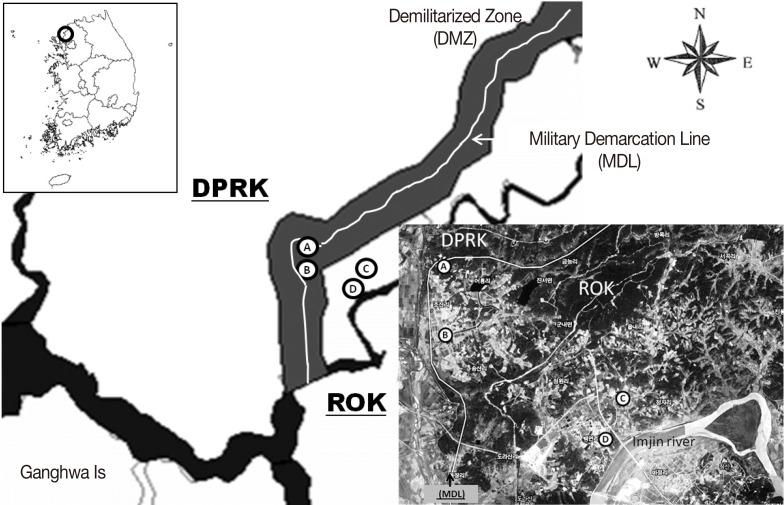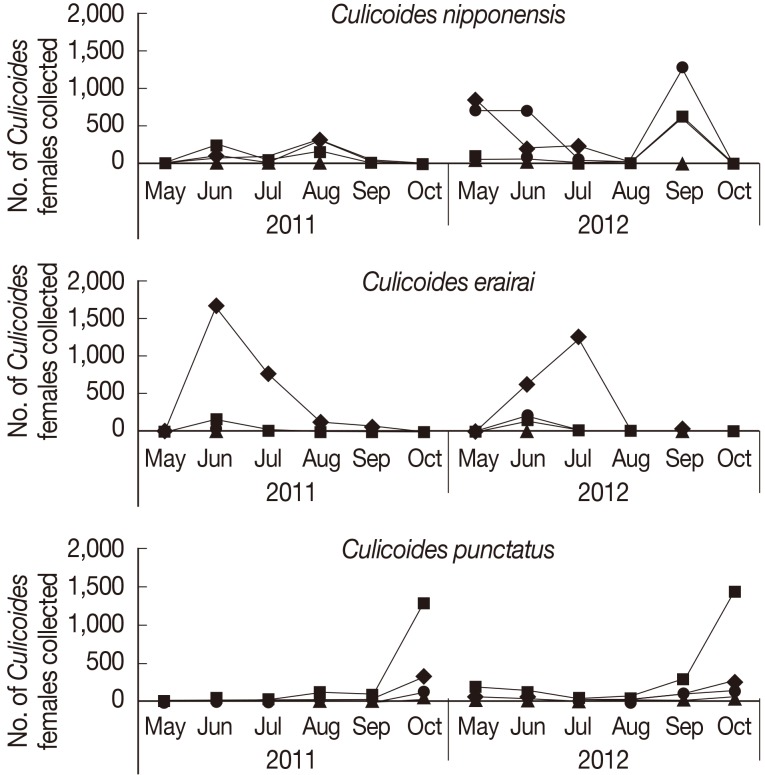Seasonal Abundance of Culicoides (Diptera: Ceratopogonidae) Collected by Mosquito Magnet® in Northern Gyeonggi-do (Province), Korea
Article information
Abstract
Biting midges (Culicoides: Ceratopogonidae) were collected by Mosquito Magnet® traps at the Neutral Nations Supervisory Commission (NNSC) camp and Daeseongdong village inside the demilitarized zone (DMZ) and near the military demarcation line (MDL) separating North and South Korea and at Warrior Base (US Army training site) and Tongilchon 3 km south of the DMZ in northern Gyeonggi Province, Republic of Korea (ROK), from May-October 2010-2012, to determine their seasonal distributions. A total of 18,647 Culicoides females (18,399; 98.7%) and males (248; 1.3%) comprising 16 species were collected. Overall, the most commonly collected species was Culicoides nipponensis (42.9%), followed by C. erairai (29.2%), C. punctatus (20.3%), C. arakawae (3.3%), C. pallidulus (1.8%), and C. circumscriptus (1.4%), while the remaining 10 species accounted for only 1.1% of all Culicoides spp. collected. The seasonal distribution of C. nipponensis was bimodal, with high numbers collected during May-June and again during September. C. erairai was more frequently collected during June-July, followed by sharply decreased populations from August-October. C. punctatus was collected in low numbers from May-September with high numbers collected during October. C. erairai was predominantly collected from the NNSC camp (85.1% of all C. erairai collected) located adjacent to the MDL at Panmunjeom in the northernmost part of Gyeonggi-do (Province), while other sites yielded low numbers of specimens.
INTRODUCTION
Culicoides spp. Latreille (Diptera: Ceratopogonidae) or biting midges are small (0.5-2.0 mm in length) bloodsucking insects that have a broad distribution and impact on human and veterinary health as vectors of viruses (bluetongue, African horse sickness, epizootic hemorrhagic disease of deer, Akabane, Aino, Chuzan, and bovine ephemeral fever viruses), protozoan parasites (Haemoproteus and Leucocytozoon spp.), and filarial worms (Onchocerca and Dipetalonema spp.) throughout their range [1-15].
The first nationwide biting midge surveys in the Republic of Korea (ROK) were reported in 1974 [16,17], with seasonal abundance and host blood meal analysis of Culicoides spp. collected from cattle and poultry farms in Gyeonggi-do (Province) reported much later [18]. More recently, a brief summary of the history of research into the Culicoides fauna and seasonal prevalence of Culicoides spp. collected at 9 cowsheds in the southern part of the ROK were reported by Kim et al. [19] along with new records of 3 Culicoides spp. (C. nasuensis Kitaoka, C. pallidulus Yu, and C. jacobsoni Macfie) [20], bringing the total number of Culicoides spp. reported in the ROK to 31.
Vector-borne disease surveillance is conducted by the 65th Medical Brigade in collaboration with the Public Health Command Region-Pacific (PHCR-PAC) to determine the species composition and seasonal and geographical distributions for mosquitoes and other biting flies, e.g., Culicoides spp., and pathogens they harbor using Mosquito Magnet® traps in/near the demilitarized zone (DMZ) that separates North and South Korea in northern Gyeonggi-do, ROK.
MATERIALS AND METHODS
Mosquito Magnet® traps (ProModel, Woodstream Corp., Lititz, Pennsylvania, USA) use counter-flow technology and propane gas to produce heat and CO2 as attractants to capture mosquitoes and other biting flies, such as Culicoides. Collections were made at 4 sites, including the Neutral Nations Supervisory Commission (NNSC) camp (37° 57' 16.39" N, 26° 40' 50.03" E), Daeseongdong village (37° 56' 26.92" N, 126° 40' 37.42" E) inside the 2-km wide demilitarized zone (DMZ) and adjacent to the military demarcation line (MDL) that separates North and South Korea and at Warrior Base, a US Army training site (37° 55' 17.01" N, 126° 44' 30.22" E), and a beef farm at Tongilchon (37° 54' 32.18" N, 126° 44' 01.88" E) located north of the Imjin river and approximately 3 km from the DMZ, Gyeonggi-do, ROK, from May-October 2010-2012 (Fig. 1). Traps at the NNSC camp were set <50 m from the MDL. Daeseongdong is a village of approximately 200 residents that is under the protection of South Korea and is approximately 100-200 m from the MDL. Rice farming is the principal activity, with an enclosed (not pastured) beef farm of <50 cattle. The Mosquito Magnet was placed at the northern most edge of Daeseongdong and approximately 100 m north of the beef farm. Warrior Base is a US military training site approximately 3 km south of the DMZ. Traps were set adjacent to the barracks where soldiers sleep during the evening hours. Tongilchon is a small village of approximately 200 residents with 2 enclosed (not pastured) beef farms of approximately 50 cattle each. It is located approximately 2 km west of Warrior Base and 3 km from the DMZ. The Mosquito Magnet was placed outside one of the beef farms adjacent to a rice paddy and dry land vegetable farming.

Survey sites for Culicoides spp. collected by Mosquito Magnet® traps in northern Gyeonggi-do (Province), Republic of Korea. A: Neutral Nations Supervisory Commission camp (NNSC), B: Daeseongdong, C: Warrior Base, and D: Tongilchon.
Mosquito Magnet® traps were operated continuously, with specimens collected twice weekly from May-October in 2010-2012. Specimens were transported to the 5th Medical Detachment, US Army Garrison, Yongsan, Seoul, ROK, where mosquitoes and other biting flies were separated. Specimens of Culicoides were transferred into 70% ethanol and identified using the keys of Arnaud [21] and the checklist of Bellis et al. [20]. Voucher specimens were submitted to the Northern Territory Quarantine Insect Collection (NTQIC) in Darwin, Northern Territory, Australia, for future reference and genetic studies.
RESULTS
A total of 18,677 Culicoides females (18,399; 98.7%) and males (248; 1.3%) comprising 16 species were collected from May-October over a 3-year period from 2010-2012. Culicoides nipponensis Tokunaga was the most commonly collected species (42.9%), followed by Culicoides erairai Kono and Takahasi (29.2%), Culicoides punctatus (Meigen) (20.3%), Culicoides arakawae (Arakawa) (3.3%), C. pallidulus (1.8%), and Culicoides circumscriptus Kieffer (1.4%), while the remaining 10 species accounted for only 1.1% of all Culicoides spp. collected (Table 1). C. nipponensis was the most frequently collected species (females and males) at Daeseongdong village (67.1%), and was commonly collected from the NNSC camp (35.6%), Tongilchon (33.9%), and Warrior Base (19.5%). C. erairai was the most frequently collected species at NNSC camp (53.6%) and accounted for 85.1% of C. erairai collected at all 4 sites (Table 1), while C. punctatus was the most frequently collected species at both Tongilchon (54.4%) and Warrior Base (28.7%).

Total number of Culicoides females (F) and males (M) collected by Mosquito Magnet® traps in northern Gyeonggi-do (Province), 2010-2012
C. nipponensis females demonstrated bimodal capture rates, with large numbers collected during May (1,754, 82.4%), June (1,479, 29.5%), and then again during September (3,332, 81.7%) (Table 2). C. erairai was more frequently collected during June (2,962, 59.2%) and July (2,154, 76.0%) followed by a sharp decline in numbers collected from August-October. C. punctatus was collected infrequently from May-September (range, 84-372) with large numbers only collected during October (2,756, 88.0%).

Seasonal prevalence of female Culicoides collected by Mosquito Magnet® at four collection sites in northern Gyeonggi-do (Province), 2010-2012
Overall, low numbers of C. nipponensis were collected during 2011, while higher numbers were observed during May-June and again during September 2012 at the NNSC camp and Daeseongdong (Fig. 2). C. erairai was collected more frequently at the NNSC camp during the months of June-July 2011 and 2012, with few collected from August-October for either year. Low numbers of C. punctatus were collected from May-September, with a sharp increases in numbers observed primarily at the beef farm at Tongilchon during October for both 2011 and 2012.

Seasonal prevalence of 3 predominant species, Culicoides nipponensis, C. erairai, and C. punctatus females, collected from Mosquito Magnet® traps at 4 collection sites in northern Gyeonggi-do (Province), in/near the demilitarized zone, Republic of Korea, 2011-2012 ( Neutral Nations Supervisory Commission camp (NNSC),
Neutral Nations Supervisory Commission camp (NNSC),  Daeseongdong,
Daeseongdong,  Warrior Base, and
Warrior Base, and  Tongilchon).
Tongilchon).
DISCUSSION
This is the first report for collections of Culicoides using Mosquito Magnet traps that use only heat and CO2 as attractants. The addition of other chemical attractants, e.g., octenol, has been shown to repel some species of culicine mosquitoes [22], while enhancing the collection of others, but the relative attractiveness of this attractant has not been investigated for most species of Culicoides. A major difference between Mosquito Magnet and light traps is that Mosquito Magnet traps operate continuously without bias toward nocturnal and diurnal active species. This difference, however, indicates that comparative analysis between data obtained from Mosquito Magnet and light traps should be viewed with caution.
Biting midges are both nuisance biters and vectors of medical and veterinary important pathogens that impact the economy of the animal industry in the ROK [14,15]. C. nipponensis, and C. punctatus were the most commonly collected species by Mosquito Magnets during this study and have been associated with the transmission of important livestock pathogens, e. g., Fukuoka, Aino, and Ibaraki viruses [5,23], or as biting pests of humans (C. erairai) [24,25]. Consequently, surveillance of these and other species of Culicoides and associated pathogens are an important part of the veterinary health service to identify relative vector populations, their distributions throughout the ROK, and the presence and prevalence of pathogens affecting livestock and poultry.
The dominance of C. nipponensis and C. punctatus in the Mosquito Magnet collections is similar to findings by Cho and Chong [17] and Kang and Yu [18] using New Jersey light traps. Similarly, Lee [26] found that C. punctatus, C. arakawae, and C. tainanus Kieffer were the most commonly collected species at inland sites, whereas C. nipponensis and C. sinanoensis Tokunaga were the predominant species collected from the south and eastern coastal areas in the ROK. Recently Kim et al. [19] found that C. punctatus and C. arakawae were the dominant species collected from light traps set in 9 cowsheds in the southern part of the ROK. The unprecedented predominance of C. erairai and relatively low numbers of C. arakawae in the Mosquito Magnet traps compared to these and other previous reports [17,27] may reflect the relative attraction of these species to light and the attractants associated with the Mosquito Magnet traps.
The dominance of C. nipponensis and C. punctatus at a cowshed at Tongilchon agrees with the host preference of these species for cattle [23,26,28]. Although C. arakawae appears to have a preference for feeding on birds [29], it also readily feeds on cattle [18,26], which would explain its abundance around cowsheds in other reports but not the low numbers collected at the cowshed at Tongilchon in this survey.
The variable distribution of Culicoides spp. over a limited area (2 km radius) demonstrates the focal species abundance due to little understood environmental and host attraction factors. For example, high numbers of C. erairai were observed at the NNSC camp where humans are believed to be the primary host, while C. nipponensis was the primary species collected at Daeseongdong and Tongilchon where a variety of hosts (e.g., cattle, dogs, large water birds, and humans) serve as potential hosts. Thus, further studies comparing light and Mosquito Magnet traps and range of available hosts may reveal differential attraction for different species and assist in surveys targeting particular species. Additionally, studies on the geographical and seasonal distributions, host attraction (e.g., placement of traps near human habitation and poultry, cattle, and swine farms), temporal biting activity, pathogen infection rates, and their role as potential vectors of zoonotic pathogens that impact on human and animal health are warranted. Although limited, the data presented herein provide a better understanding of the biology, ecology, and environmental parameters that affect relative population abundance of Culicoides spp. that can be used to predict potential human and animal health risks and develop and implement mitigation strategies.
ACKNOWLEDGMENTS
We thank the commander and soldiers of the 5th Medical Detachment, 168th Multifunctional Medical Battalion, 65th Medical Brigade, for their assistance in conducting vector-borne disease surveillance. We also thank 1LT Adam Irby and 1LT Christopher Taylor, Physician Assistants, and their medical staff, United Nations Command Support Battalion, Camp Bonifas, for their assistance and coordination for mosquito and other biting fly collections at the NNSC camp and Daeseongdong. We thank Mr. Chang-Hun Pak, Foreman of the Pest Control Section, Department of Public Works at Camp Casey, Installation Management Command-Korea, for assistance in conducting of Culicoides spp. collections. Funding for this research was provided by the Armed Forces Health Surveillance Center, Global Emerging Infections Surveillance and Response System (AFHSC-GEIS), Silver Spring, Maryland, USA, the National Center for Medical Intelligence, Fort Detrick, Maryland, USA, the Public Health Command Region-Pacific, Camp Zama, Japan, and the Animal and Plant Quarantine Agency, Anyang, Gyeonggi Province, Republic of Korea. The opinions expressed herein are those of the authors and are not to be construed as official or reflecting the views of the US Department of the Army, Department of Defense, or the US Government.